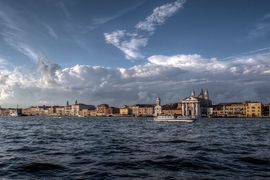At the 2016 Venice Architecture Biennale, opening Saturday, architects and designers have responded to a charge to “report from the front” on major challenges and issues facing humanity around the globe.
In installations throughout Venice — from the historic venues of the Arsenale and Giardini on the island’s eastern tip, to repurposed palazzos and churches across the city — MIT faculty, alumni, and students are among the contributors offering varied and potent responses. Their efforts, considered alongside numerous others displayed in scores of exhibitions and pavilions, may signal a paradigm shift for architecture, participants say.
Considered one of the foremost global forums for architecture and the built environment, and drawing hundreds of thousands of visitors from around the world, the Architecture Biennale takes place every two years in Venice. The 2016 curator, Chilean architect and Pritzker Prize winner Alejandro Aravena, chose as his theme “reporting from the front,” focusing on architecture’s capacity to improve the human condition by addressing problems such as segregation, inequality, suburbia, sanitation, natural disasters, housing shortages, migration, crime, traffic, waste, pollution, and community participation.
“If the current condition is that you deal with only projects that interest other architects, then let’s [instead] try to start from projects that interest every single citizen,” said Aravena. “Once that is done, then use the specific knowledge of architecture to address those issues — go from nonspecific problems through the specific knowledge of architecture to try to make a contribution.”
If past versions of the Biennale have sometimes leaned toward the high-concept and avant-garde, Aravena’s issue-oriented theme gives this year’s event a feeling of purpose and application.
“It's fascinating to see our faculty leading on multiple fronts: thinking through architecture's relationship with building and design technologies, geopolitics, and resource depletion,” said J. Meejin Yoon, professor and head of the Department of Architecture at MIT. “The Biennale brings together architects and designers from around the world — and, in this exhibition in particular, those who represent an incredible commitment to positive change in society and environment through architecture and design.”
The MIT presence at the Biennale is widespread in terms of both geography and issues. The faculty, alumni, and students presenting in Venice comprise more than a dozen nationalities and countries of origin, and their Biennale projects represent projects on five continents. Their areas of concern are just as broad.
Some MIT-related projects introduce technological innovations for building but then apply them to social and environmental concerns. John Ochsendorf, the Class of 1942 Professor of Architecture and professor of civil and environmental engineering is part of two projects — in collaboration with MIT alumni Matthew DeJong and Philippe Block — that demonstrate the structural, economic, and environmental benefits of compression vaults. Assistant professor of architecture Alexander D’Hooghe and his firm, ORG, created an innovative system of modular concrete panels; in a design for an urban market for immigrants in Brussels, the structure reinforces the notion of an open society.
Other projects consider how rural and urban contexts shape the design process. The exhibition from Ensamble Studio, headed by professor of architecture Antón García-Abril and MIT research scientist Débora Mesa, examines the often conflicting challenges of designing for urban or natural settings. Visiting professor Clara Solà-Morales considers the constructed environment as more than just walls and explores how the landscape becomes part of architecture and vice versa.
Several contributions celebrate, critique, and reveal history through the built environment. In the Brazilian Pavilion, MIT alumna and urban planner Sara Zewde’s “Circuit of African Heritage” presents a plan for a series of historic sites in Rio de Janeiro to acknowledge the black experience and its contributions to the country’s culture. Gediminas Urbonas, director of the MIT Program in Art, Culture, and Technology, and MIT research affiliate Nomeda Urboniene, also traces the impact of a historic structure: the Druzhba pipeline built by the Soviet Union. In the Baltic Pavilion, located in a local gymnasium, their thought-provoking installation spills down the bleachers like an oil slick.
The MIT contributions also include more speculative investigations. Kevin Slavin, director of the Playful Systems Group in the MIT Media Lab, has developed a modified beehive that captures “bee debris” for genetic sequencing, to create microbiological portraits of cities and neighborhoods; he has installed a working hive at the Palazzo Mora alongside videos visualizations of bee-sourced data. Rania Ghosn and her practice, Design Earth, imagines what the post-oil urban and social landscape of the Pan-Gulf region.
“We come here for inspiration, we come here to share ideas, we try to show how architecture can change the world. The Biennale is really about celebrating architectural design on every scale and every level,” said Ochsendorf. “In my case, it’s the first time I’ve ever been to a Biennale, so it’s exciting to be here, but it’s also very exciting to have a chance to showcase our research over 15 years coming to fruition and having a chance to share that with the world.”

















